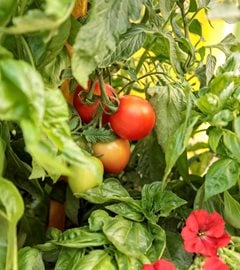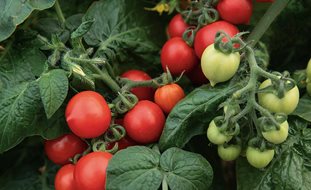HOW TO GROW TOMATO PLANTS
Everything you need to know to grow and use this vegetable garden favoriteTempting Tomatoes® 'Garden Gem'. Photo by Proven Winners.
Few summertime pleasures are more sublime than biting into a rich, juicy tomato right out of the garden. Once you’ve tasted homegrown, you’ll never go back. This staple of Mediterranean cuisine is a member of the nightshade family (Solanaceae), and is classified as a fruit, but prepared and eaten as a vegetable.
Some gardeners have been discouraged to grow tomatoes because of the number of diseases and pests that can infect and damage plants. However, by growing disease-resistant varieties, anyone can grow a delicious crop of homegrown tomatoes.
On this page: Basics | Types | Planting | Care | Pests, Diseases, and Problems
On this page:
BASICS
Botanical name:
Lycopersicon esculentum (syn. Solanum lycopersicum)
Zones:
10-11, usually grown as an annual
Height/Spread:
Bushy, sprawling, or vining habit; 1-10 feet tall and 1-3 feet wide
Exposure:
Full sun
Foliage:
This quick-growing, tender bush or vine is densely branched with hairy, fleshy stems and hairy, lobed leaves which are distinctly scented.
Flowers and fruit:
Star-shaped yellow flowers are followed by red, orange, yellow, purple, pink, black, or green fruit. Fruit can be round, oval, or pear-shaped, ranging from 1/2-inch cherry-sized to hearty beefsteaks weighing several pounds.
Toxicity:
Ingestion of leaves, stems, and unripened fruit can be toxic to dogs and cats. Ripe tomatoes are non-toxic, though some pets may experience stomach upset or an allergic reaction. Sensitive people may be allergic to eating the fruits or develop a skin rash from contact with plants. Symptoms can be mild or severe.
Deer resistance:
Most plants in the Solanum family, including tomatoes, are distasteful to deer. However, gardeners report mixed experiences, with some finding little or no deer damage, while others have had their tomato plant heavily grazed.
TYPES OF TOMATOES
All tomatoes are either determinate, indeterminate, or semi-determinate.
- Determinate tomatoes: Also called bush tomatoes, plants grow 1-3 feet tall and produce one big crop.
- Indeterminate tomatoes: Also called vining tomatoes, plants grow up to 10 feet tall and produce tomatoes throughout the season.
- Semi-determinate tomatoes: Plants are more compact than indeterminate plants and produce all season.
Heirloom vs Hybrid?
- Heirloom: Heirloom varieties have been around for hundreds of years, tend to have the best flavor, and grow true from seed.
- Hybrid: Hybrids are a cross between two or more tomato varieties, bred for particular traits such as disease-resistance and cold hardiness. They tend to be less flavorful than heirlooms.
Common types of tomatoes:
Tomatoes come in different sizes, shapes, and water content, which can help determine what kind to grow and how to use them. Learn more about how to choose the right tomatoes to grow.
Some of the most common types are beefsteak, campari, pear, plum, salad, grape, and cherry.
HOW TO PLANT TOMATOES
When to plant tomatoes:
Tomatoes will fail to thrive unless temperatures are optimal. Nights should be consistently no lower than 55 degrees F, while soil temperature should be at least 60 degrees. Prolonged heat over 90 degrees F will cause fruit and flower production to halt. Planting before it's warm enough can result in stunted plants. Planting too late can result in low yields or unripened fruits.
Where to plant tomatoes:
Tomatoes need at least 6-8 hours of full sun, along with plenty of heat to thrive. Rotate the site every year to prevent soil-borne diseases and insect infestations. Tomatoes should not be planted in the same spot where eggplant, peppers, or potatoes have recently been grown. Avoid planting tomatoes near corn or plants in the Brassica and Solanum families.
Planting tomato seedlings or young plants:
Turn garden soil to a depth of 8 inches and amend with rich organic matter. Tomatoes can develop roots along any part of the stem that is submerged under soil. Burying the lower part of the plant will encourage more roots and sturdier growth. Cut off side branches on the part of the stem that will be submerged. Add a 1- to 2-inch layer of mulch (organic matter) around plants to conserve water and control weeds.
Tomato plant spacing:
Place larger indeterminate types 3 feet apart. Compact determinate types can be spaced 2 feet apart. Allow 3 feet in between rows.
Starting tomato seeds:
Sow tomato seeds 6-8 weeks before the final frost date in your area. Plant seeds 1/4-inch deep in a seed-growing medium. Keep soil moist and indoor air temperature at 70 degrees F or warmer for germination in 7-14 days.
Once seedlings emerge, provide ample window light or use fluorescent plant lights for 16 hours a day. When the first set of true leaves develops, fertilize once a week at half strength. Transplant into 3- to 4-inch containers when plants have 3 sets of leaves. Wait until all danger of frost is past to transplant outdoors, gradually acclimating plants to avoid shock.
Many specialty and heirloom varieties are only available from seed.
Learn more about how to grow tomatoes from seed.
Planting tomatoes in pots:
Choose a site on a patio, balcony, or deck that gets at least 6-8 hours of direct sun throughout the summer. Use determinate types which will stay smaller. Containers should be at least 5 gallons or larger (12 inches wide and deep) for each plant and have good drainage. Use high-quality potting soil and mix time-release fertilizer into the planting hole.
Containers will need more frequent watering and fertilizing than plants in the ground. Once plants set fruit, fertilize every 1-2 weeks with a balanced liquid organic fertilizer such as fish emulsion. Learn more about how to grow tomatoes in pots.
Hanging tomato plants:
For those with limited space, try growing tomatoes in a hanging basket or upside down tomato planter.
Growing indoor tomato plants:
Growing tomatoes indoors year-round is only recommended for the most experienced gardener. Use a heated greenhouse or dedicated room with grow lights. Temperatures should range between 60-85 degrees F for fruit set. Plants will need hand pollination and at least 8 hours of bright light daily.
Season extenders:
Warming aids help jump start growth early in the growing season when temperatures are still cool. This is especially helpful for those in short-season climates. Cover the ground area around plants with black plastic sheeting, which will absorb heat and suppress weeds. Other season extenders include row covers, hoop houses, or water walls.
Tomato companion plants:
Companion planting refers to the symbiotic relationship of how certain plants can benefit from the close proximity of others. Good companion plants for tomatoes include asparagus, basil, borage, mint, parsley, lettuce, spinach, peas, carrots, celery, beans, garlic, onions, squash, nasturtium, and marigolds. Learn more about companion planting.
TOMATO PLANT CARE

Tempting Tomatoes® Goodhearted®. Photo by: Proven Winners.
Soil:
Tomatoes need rich well-draining soil that stays moist but not soggy. Work compost, aged manure, worm castings, or a combination into existing soil. They prefer a slightly acidic pH between 6.0 and 7.0.
Amendments & fertilizer:
Tomatoes are fast growers and heavy feeders, needing regular supplemental fertilizer to produce well. There are many different methods and amendments available.
- At planting time, add a slow-release fertilizer to the planting hole according to instructions. Use a balanced 10-10-10 fertilizer or a blend formulated for tomatoes.
- Water newly planted seedlings with a starter fertilizer solution to jump-start growth.
- Once plants begin to set fruit, fertilize every 1-2 weeks with fish emulsion, compost tea, or other water-soluble organic fertilizer.
- Make sure plants receive adequate calcium to help prevent blossom end rot.
- Other organic supplements that benefit tomatoes include bone meal, cottonseed meal, lime, egg shells, and used coffee grounds.
For more tips on fertilizing: Garden Fertilizer 101
Watering:
Plants need regular water to grow well. The rule of thumb is to water slowly and deeply to encourage a deep root system.
- Irrigate in the morning and avoid overhead watering, which will help prevent fungal diseases.
- Underwatering will stress plants and stunt growth.
- Overwatering can cause root rot, fungal disease, and loss of fruit quality.
- Irregular watering can result in problems such as blossom drop, fruit cracking, or blossom end rot.
- For raised beds and plots, use drip irrigation or a soaker hose to deliver water to the roots most efficiently.
- For containers, water around the base of the plant with a watering wand. Water twice weekly, or more often during extreme heat spells.
- See more: Complete Guide to Watering Tomato Plants.
Pruning tomato plants:
To direct energy toward producing fruit rather than foliage, tomato plants can be pruned, though it’s not necessary. Pruning can also help ward off pests and diseases by increasing air circulation and light.
- Pinch out suckers that grow between the main stem and branches; these will produce few if any fruits.
- Remove the suckers when small (less than pencil width) to prevent plant shock.
- Trim out lower branches to prevent water splash on the leaves, which can promote fungal diseases.
- Indeterminate vining types can be pruned down to a single leader so they can be trained up a stake or string trellis.
- See more: How to Prune Tomato Plants.
Support:
Tomatoes need support to keep plants and fruits off the ground. Use stakes or tomato cages for small determinate bush types. Larger indeterminate vining types will need heavy duty stakes or cages, ladders, or trellises. (Read more: Staking Tomatoes: A Simple How-To Guide)
Harvesting:
Fruit should be left on the plant plant as long as possible to develop the best flavor. Here are some tips to help you determine if your tomatoes are ready to be picked:
- Ripe fruit should be fully colored, though some heirlooms can retain some green around the stems.
- Fruit should be firm but slightly soft, not mushy.
- Plum and other types with less water content will stay more firm.
- Cherry tomatoes are susceptible to cracking if left on the vine for too long.
- Overripe fruits may drop off the plant.
What better way to enjoy your home-grown tomatoes than with delicious recipes!
Picked fruit should be kept at room temperature on a counter or windowsill until using. Storing in the refrigerator can result in loss of flavor.
Once daytime temperatures fall below 60 degrees F, fruit will cease ripening. When this occurs, pull up the entire plant and hang upside down in a dark space such as the garage or basement to finish ripening. Or, pick and store unripened fruits in a paper bag or cardboard box between layers of newspaper to finish ripening. Use green tomatoes fresh, cooked, or preserved.
Fall cleanup:
Dispose of spent plants in municipal trash or yard debris pickup. Don’t bury or compost the plants, as pathogens can remain and be passed on to the following year’s crops.
TOMATO PESTS, DISEASES, AND PROBLEMS

Red spider mites on tomato leaf. Photo by: Catherine Eckert / Shutterstock
There are many pests and diseases that can impact tomato crops, but growing disease-resistant varieties will help ensure that you have a healthy crop of tomato plants.
Pests:
The most common pests include aphids, cutworm, blister beetle, tomato fruitworm, flea beetle, stinkbug, leafhoppers, spider mites, nematodes, slugs and snails, tomato hornworm, and whiteflies.
Diseases:
Most diseases are fungal-related and are due to improper watering practices, excess humidity, and poor air circulation. Diseases include early and late blight, gray leaf spot, septoria leaf spot, verticillium wilt, anthracnose, bacterial wilt, leaf mold, fusarium wilt, tobacco mosaic virus, damping-off disease, tomato yellow leaf curl virus, and tomato spotted wilt virus.
Problems:
Other problems include flower drop, blossom end rot, leaf roll, catfacing, poor fruit set, and fruit cracking.
Learn more about identifying and troubleshooting common tomato diseases, pests, and problems.
Tempting Tomatoes®
One of the easiest ways to ensure healthy tomatoes is to grow disease-resistant varieties, such as:
MORE ON GROWING TOMATOES
RELATED:
14 Summer Vegetables to Grow
Garden Edibles: Success Secrets
Growing Peppers
How to Grow Strawberry Plants











